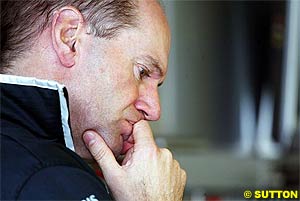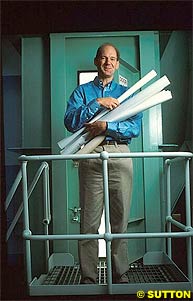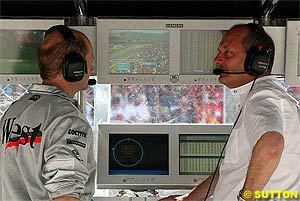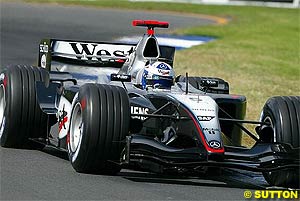
Exclusive Interview with Adrian Newey
Atlas F1 Senior Writer
There used to be a time when the common belief has been that any average driver could win a World Championship in a car designed by Adrian Newey. But there is more to winning in Formula One than a good chassis or a brilliant aerodynamicist, and, as Newey tells Atlas F1, he can only do his bit. Involved less in race engineering - his big love - and with a growing pressure on his team to deliver, what odds are there against Newey leaving Formula One when his contract expires next year? Roger Horton met with the Briton to find out
By the late nineties common wisdom was that so good was Newey that even an average driver could win in one of his cars. To this day controversy amongst some fans still rages concerning the relative merits of Nigel Mansell, Damon Hill and Jacques Villeneuve because they won their Championships with Newey inspired gems that were the class of the field.
During those years Newey didn't create the whole package. He had for all of his time at Williams the acknowledged best engine in the business - Renault - to power his creations. So when Ron Dennis prised him away from Williams with a fat pay check and the promise of more authority, it looked as if McLaren would rule the roost for years to come. 'Who needs a Shuey when you have a Newey' became something of a media joke in reference to the mega bucks being paid to Michael Schumacher by Ferrari in their ultimately successful quest for World Championships.
Newey became the sport's superstar designer, a mantle that never sat comfortably with such a modest and self effacing man. Compared to some other technical directors in the other leading teams Newey seems to shun the limelight. "I enjoy the engineering. I enjoy working with the drivers and those are the aspects I like," Newey says. "I don't mind doing interviews and publicity and everything, but I don't seek it."
With McLaren under intense media scrutiny after some years of relative underperformance and a somewhat disastrous opening race in Melbourne, Newey was reluctant to discuss the specifics of the problems that were so painfully exposed around Albert Park's lakeside track. "I think 1999 was pretty even, although I think we probably had the fastest car," Newey told Atlas F1 after Fridays opening practice session in Australia. "In 2000 arguably we had the fastest car but under performed probably more with reliability more than anything else. But yes, from 2001 until today we have not been at the level where we would like to be."
Pressed on which elements of the current package was letting the team down, Newey was naturally reluctant to point any fingers although as technical director he takes full responsibility for the chassis performance, which of course includes his forte aerodynamics.
"I can only do my bit," he says when faced with a line of questioning on McLaren's current form. "We haven't always come out with the best car… But I don't know what you want me to say, to be perfectly honest. Yes, McLaren have been through rough patches before. So have Ferrari and Williams. It happens. If you can't get the package together then you struggle for a while."
Moving away from his current problems at McLaren, I go back to the reason he started his McLaren career in the first place and whether Damon Hill's sacking by Williams was a factor in his decision. "A small factor," he confirms. "There was a whole host of reasons. Ultimately I wanted to be in a position where I had technical control - in particularly the design of the car, but be involved in the whole decision making process of the factors that control the performance of the car."
RH: And you have that at McLaren?
Newey: "yes, I do."
Newey: "Less than I did. When I first joined McLaren I was closely involved with Mika [Hakkinen] for the first couple of years."
RH: Can I ask why that was?
Newey: "Yes, it was almost the same position as happened with Damon actually, in both cases the race engineer for the respective driver for the previous year had in one case left and the other case changed positions. So we decided in both cases to promote engineers from within to become the new race engineers, but initially I took an overview to sort of help them along whilst they found their feet, which I enjoyed doing, and working with a driver closely helped me understand how the car is behaving and what needs to be changed - not just from the race engineering aspect, but from a fundamental design and research aspect as well."
RH: Has that continued on with Kimi Raikkonen?
Newey: "No. What I have always found is that I find it very difficult personally to work with two drivers at once, closely. So when Mika left I started to work more closely with David [Coulthard] and that has continued. No reflection at all on the driver, that's simply the way it's worked out."
RH: Working first hands on with Damon and later with Mika and now David, doesn't it affect the other driver if you are working closely with their teammate?
Newey: "I supposed it depends on the strength of character of the driver, really. As I say, when I race engineer it's almost for my own enjoyment for the understanding of the car. But since Mika retired, I haven't been as closely involved with a driver as I was with Mika and previously with Damon, mainly through time pressures and circumstances."
RH: Obviously as technical director, if you are race engineering one car, doesn't that raise the question that one driver may get the future developments engineered to his preference?
Newey: "There is that possibility, it depends really whether you have two drivers with completely different driving styles or whether you have similar demands on the car. I haven't really found it to the point where it has affected the research and development of the car, to the point of finding different solutions. Usually driver preference can be found within the set up of the car."
RH: How do David and Kimi compare as to what they want from the car?
Newey: "Similar but not identical. Kimi has always been very similar to Mika in what he wants from the car. Their set ups are pretty close and they can drive each other's set ups."
RH: Kimi has this 'ice-man' image, is he like that all the time within the team?
Newey: "Yes, generally."
RH: So when Juan Pablo Montoya arrives next season you are really going to have two drivers that are chalk and cheese…
Newey laughs. "Yes, it will be opposite ends of the spectrum with their personality."
RH: Over at Renault, Mike Gascoyne had this system of two design teams overlapping. Is this an idea that you have explored?
"From a chassis manufacturer's point of view I am less convinced that you need two teams as such. If there are particular areas where you have long lead time research projects, then yes, you need to put people on those projects that can stay there."
RH: Well it seems to be working for Renault, doesn't it. They appear to have made tremendous progress.
Newey: "Yes, they have made tremendous progress; they have a very good car. Equally, if you look at this year's car compared to last year's, it looks to have been an evolutionary step so to say it's the work of two different design teams can't be the case."
RH: I understand that the teams have still not received clarification from the FIA regarding the Michelin front tyre issue. Is that correct?
Newey: "It is open to Charlie Whiting's interpretation, yes. Basically what Charlie has said is that if he feels the tyre is over width he has to make a judgement as to what is systematic contact with the track surface and what is an occasional abrasion through kerb strikes and that sort of thing. That will be a judgement call and hopefully that will never lead to tricky situations, but there is always that danger."
RH: In hindsight, do you believe this tyre issue cost you much last year?
Newey: "No, not really. The cost was really the distraction it caused at the time more that anything. In performance terms I don't think it made any difference."
RH: What is your role at races? Are you involved in pitstop strategy for example?
Newey: "Yes, but less so than I used to be, and less so, as I said, with the race engineering. The way the race weekends are now, there is much less race engineering to do now, and actually it is much more useful to go to tests because there is so little running [in a GP weekend], what with the new timetable and the single engine rule, where we are all trying to save mileage. So the real race engineering that we do is depressingly small."
RH: So who decides on pitstop strategy?
Newey: "No single person is the answer. It's a group of people which would include the driver's race engineer, myself, Ron."
RH: Are the drivers free to choose their own strategy?
RH: So it's OK to mess up those Red cars but not OK to compromise your own team?
Newey: "Yes it's inevitably a problem when you have two drivers that you are trying to treat equally. At Ferrari they clearly don't have that problem."
RH: There have been speculation that that one day you will leave Formula One and do something completely different. Is that something you are thinking about?
Newey: "I have greatly enjoyed motor racing through the years, but I don't want to do it for all my life, that's for sure. So at some stage in the distant future I will take a sabbatical for a year and then see from there, because I have been in motor racing since I was 21 years old and it's been a great career, but I would like to do some other things. It is all absorbing."
RH: And every two weeks you get an exam
Newey smiles ruefully. "That's right."
Adrian Newey only ever wanted to pursue one goal in life, and that was to be a racing car designer. It was his dream since he was a "repressed" schoolboy at the famous Repton Public School in the English Midlands. He escaped at sixteen to study the Ordinary National Diploma at a Technical College and then to Southampton University to study aeronautics.
 By 21 he was in motorsport full time and the rest is motor racing history. Design teams led by Newey, firstly at Williams and then at McLaren, have won six of the last twelve Constructors' titles, the ultimate accolade for a technical director or chief designer.
By 21 he was in motorsport full time and the rest is motor racing history. Design teams led by Newey, firstly at Williams and then at McLaren, have won six of the last twelve Constructors' titles, the ultimate accolade for a technical director or chief designer.
 RH: Despite being very senior in the team you always appear to be happiest when you are in a hands-on race engineering mode. Are you still doing hands race engineering work?
RH: Despite being very senior in the team you always appear to be happiest when you are in a hands-on race engineering mode. Are you still doing hands race engineering work?
 Newey: "I think it is down to how you allocate your resources and whether you have the personnel to operate that approach. I think that if you go to that approach you are doing it because you think the lead times are so long because you want to be into the research and development of the next car before you have completed development of the existing one, if you like. Now clearly with an engine, for example, where the lead times are much longer, then I can see the benefit of going that route.
Newey: "I think it is down to how you allocate your resources and whether you have the personnel to operate that approach. I think that if you go to that approach you are doing it because you think the lead times are so long because you want to be into the research and development of the next car before you have completed development of the existing one, if you like. Now clearly with an engine, for example, where the lead times are much longer, then I can see the benefit of going that route.
 Newey: "Yes, provided it's not detrimental to the team. The traditional one in days gone by was the one stop race with the benefit going to the guy who ran slightly longer than his teammate and if he did that he could usually stay ahead. We had a system where whoever qualified ahead could get first choice on the fuel they would carry. Then we had the situation where our two guys were carrying heavier and heavier fuel loads to combat each other with the net results that, yes, they achieved what they wanted but they were comprising their overall race result compared to their competitors and that's a problem which one has to manage as best one can."
Newey: "Yes, provided it's not detrimental to the team. The traditional one in days gone by was the one stop race with the benefit going to the guy who ran slightly longer than his teammate and if he did that he could usually stay ahead. We had a system where whoever qualified ahead could get first choice on the fuel they would carry. Then we had the situation where our two guys were carrying heavier and heavier fuel loads to combat each other with the net results that, yes, they achieved what they wanted but they were comprising their overall race result compared to their competitors and that's a problem which one has to manage as best one can."
|
Contact the Author Contact the Editor |
Please Contact Us for permission to republish this or any other material from Atlas F1.